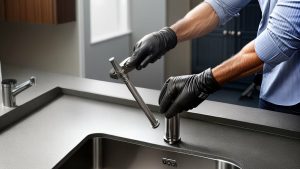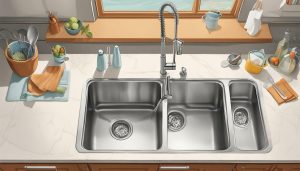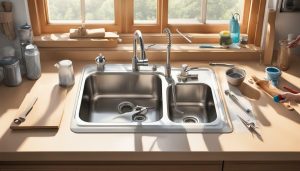Are your kitchen cabinets in need of a makeover? Rather than spending a fortune on new ones, why not try refinishing them yourself? Refinishing your cabinets is an affordable way to breathe new life into your kitchen. Plus, it’s a satisfying DIY project that can be done over a weekend.
In this step-by-step guide, we’ll walk you through the process of refinishing your kitchen cabinets. From understanding the cabinet refinishing process to applying a protective finish, we’ve got you covered. Let’s get started!
Key Takeaways:
- Refinishing your kitchen cabinets is an affordable and rewarding DIY project
- The process involves removing hardware, cleaning and sanding the surfaces, applying paint or stain, and adding a protective finish
- This guide will provide step-by-step instructions and tips for achieving a professional-looking finish
Understanding the Cabinet Refinishing Process
If you’re considering a kitchen cabinet renovation, cabinet painting or updating kitchen cabinets, refinishing your cabinets can be a cost-effective and rewarding DIY project. Refinishing kitchen cabinets involves several steps, each crucial to achieving professional-looking results. Here’s a step-by-step guide to help you understand the cabinet refinishing process:
Step 1: Remove Hardware
Detaching cabinet hardware is the first step in the cabinet painting process. You will need to use a screwdriver to remove all hardware, including hinges, door handles, and drawer pulls. This prevents paint or stain from sticking to the hardware and ensures a smooth finish on the cabinet surfaces.
Step 2: Clean the Cabinets
Proper cleaning is essential to remove grease, dirt, and grime that may have accumulated on the cabinet surfaces over time. Use a cleaning solution or degreaser to ensure the surface is free of contaminants. Allow the cabinets to dry completely before proceeding to the next step.
Step 3: Sand the Surfaces
Sanding the cabinet surfaces is necessary to create a smooth and even surface for the refinishing process. Use sandpaper with the appropriate grit for the job, and be sure to sand in the direction of the wood grain. This step will allow the primer and paint or stain to adhere better to the surface.
Step 4: Apply Primer
A coat of primer helps the paint or stain adhere better to the cabinet surface. Use a brush or roller to apply a thin coat of primer, ensuring even coverage. Allow the primer to dry completely before proceeding to the next step.
Step 5: Apply Paint or Stain
Once the primer has dried, you can apply the paint or stain of your choice. Use a brush or roller to apply a thin layer of paint or stain, and be sure to apply in even strokes. Allow the first coat to dry completely, then apply a second coat if necessary.
Step 6: Apply a Protective Finish
Applying a protective finish such as varnish or polyurethane is an optional but recommended step. This helps protect the cabinets from wear and tear, and ensures a long-lasting finish. Allow the protective finish to dry completely before reinstalling cabinet hardware and doors.
By following these steps, you can effectively transform the look of your kitchen cabinets with minimal effort. Whether you’re looking to update your kitchen with a cabinet renovation or cabinet painting, this DIY project is sure to bring new life to your kitchen space.
Gathering the Necessary Tools and Materials
Before beginning the kitchen cabinet refinishing project, it’s important to have all the necessary tools and materials at hand. Here’s a comprehensive list of everything you’ll need:
| Tools | Materials |
|---|---|
| Screwdriver | Sandpaper (120 and 220 grit) |
| Drill | Painter’s tape |
| Hammer | Drop cloths |
| Paintbrushes (angled and straight) | Tack cloth |
| Roller and roller covers | Wood filler |
| Sanding blocks | Degreaser or trisodium phosphate (TSP) |
| Protective eyewear and gloves | Primer |
| Mask or respirator | Paint or stain |
Keep in mind that some of these tools and materials can be substituted with more affordable options. For example, you can use a foam roller instead of a pricier microfiber roller or opt for a cheaper degreaser instead of TSP.
By having all these tools and materials ready, you can ensure a smoother and more efficient refinishing process – transforming your kitchen cabinets and giving your kitchen a DIY facelift!
Preparing Your Kitchen Space for Refinishing
Before you begin refinishing your kitchen cabinets, it is important to prepare the space properly to avoid any potential damage to countertops, floors, or surrounding areas. Follow these tips to ensure a smooth and successful refinishing process:
- Clear the area: Remove all items from the countertops and surrounding area, including small appliances, dishes, and decorative items. This will provide enough space for you to work and avoid any potential damage to these items.
- Cover countertops and floors: Use drop cloths or old towels to cover the countertops and floors. This will protect them from dust, paint, and stain.
- Remove cabinet doors and hardware: Take off the cabinet doors, hinges, and hardware, and store them in a safe place. Label them to make the reinstallation process easier later.
- Clean the cabinet frames: Use a gentle cleaner to remove any grease or dirt from the cabinet frames. This will ensure a smooth and even surface to work with.
- Sand the frames: Sand the cabinet frames lightly to roughen the surface and prepare it for painting or staining. Use a fine-grit sandpaper to avoid damaging the wood.
- Protect the surrounding area: Use painter’s tape to cover areas that are not being refinished, such as backsplashes or wall edges. This will prevent any accidental paint or stain marks.
By following these simple tips, you can ensure that your refinishing process goes smoothly, and your kitchen looks updated and refreshed.
Removing Cabinet Hardware and Doors
Before you can start refinishing your kitchen cabinets, you need to remove the cabinet doors and hardware. This is a crucial step to ensure that you can access all the nooks and crannies of your cabinets
Tip: Don’t forget to label each door and hardware piece as you remove them for easier reinstallation later on.
Here’s a step-by-step guide for removing cabinet hardware and doors:
- Using a screwdriver, remove all the door hinges and hardware from the cabinet frame.
- If your cabinets have drawer pulls, remove them too.
- Place all the hardware in a container or bag and label them accordingly.
- Remove the cabinet doors by lifting them off the hinges.
- Store the cabinet doors in a safe place, such as on a flat work surface covered with a protective layer to avoid scratches.
Once you have removed the doors and hardware, take some time to clean them thoroughly. This will ensure that the refinishing process goes smoothly and the cabinets look like new again.
Cleaning and Sanding the Cabinet Surfaces
Before refinishing your kitchen cabinets, it is essential to clean and sand the cabinet surfaces to ensure a smooth and even finish. Here are the steps you need to follow:
- Remove cabinet doors and hardware: Begin by removing the cabinet doors and hardware. Label each piece of hardware in accordance with the cabinet it belongs to, making sure you don’t lose any screws or hinges.
- Clean the cabinet surfaces: Spray a degreaser on the cabinet surfaces and wipe them clean with a soft cloth. This will remove any dirt, grease, or grime that has accumulated on the cabinets over time.
- Sand the surfaces: Use a fine-grit sandpaper to sand the surfaces of the cabinets. This will help remove any old paint or varnish that may be present and help prepare the surface for the new finish. Make sure to sand in the direction of the wood grain.
- Clean up: Lastly, use a tack cloth to remove any dust or debris left on the cabinet surfaces after sanding. This will ensure a smooth and even surface for the refinishing process.
By cleaning and sanding your kitchen cabinet surfaces properly, you’ll be able to achieve a professional-looking finish that will last for years to come. Don’t rush this step – take your time to ensure that the surfaces are properly prepared before applying any paint or stain.
Applying Paint or Stain to the Cabinets
Now that the cabinets are clean and sanded, it’s time to apply the paint or stain of your choice. This step may require some patience and attention to detail to achieve a professional finish.
Note: Before starting, ensure that the area is well-ventilated to prevent inhaling paint fumes. Additionally, make sure to use protective gear such as gloves, a face mask, and goggles to avoid skin irritation and eye damage.
When selecting paint or stain, choose a high-quality product that is suitable for your cabinets’ material. Use a brush or roller to apply paint evenly to the surface, making sure to cover any gaps or crevices. For a smooth finish, use long, even strokes, following the grain of the wood.
If you choose to use a stain, follow the same techniques, but take extra care to apply it evenly and quickly to avoid blotches or uneven coloring. Additionally, make sure to wipe away any excess stain with a clean cloth immediately after applying.
After applying the first coat, allow it to dry completely before applying a second coat. This will help ensure that the paint is even and smooth. Depending on the type of paint or stain you use, you may need to apply more than two coats to achieve the desired finish.
Once you have applied the final coat, allow it to dry completely before applying a protective finish.
Applying a Protective Finish
Once the paint or stain has dried completely, it’s time to apply a protective finish to seal everything in and ensure long-lasting results. There are several options available, including varnish or polyurethane.
Before applying the protective finish, make sure the cabinets are completely clean and free of any dust from the sanding process. If necessary, use a tack cloth to remove any remaining particles.
When applying the protective finish, use a high-quality brush or roller to achieve an even coat. Apply the finish in thin layers, allowing each layer to dry completely before applying the next one. Depending on the type of finish, you may need to apply multiple coats.
Once the final coat has dried, inspect the cabinets for any areas that may need touch-ups. If everything looks good, allow the cabinets to dry completely according to the manufacturer’s instructions.
Applying a protective finish is a crucial step in the cabinet refinishing process. It not only protects the cabinets from damage but also enhances their overall appearance.
Reinstalling Cabinet Doors and Hardware
After completing the refinishing process, it’s time to reinstall the cabinet doors and hardware. This step is crucial to ensure that your cabinets not only look great but also function properly. Here’s a step-by-step guide on how to reinstall cabinet doors and hardware:
- Clean the cabinet boxes and doors thoroughly to remove any sanding dust or debris that may have accumulated during the refinishing process.
- Begin by reinstalling the hinges on the cabinet boxes. Make sure to align them properly and use screws to secure them in place.
- Next, reinstall the cabinet doors onto the hinges. Using a drill, screw the hinges onto the doors, ensuring that they are aligned and level with each other.
- Label and organize the hardware according to their specific location on the cabinets, to make reinstallation much easier.
- Install the knobs, handles or pulls on the doors, referring to the labels to ensure that each piece of hardware is placed in the correct location.
- Adjust all hinges, knobs, and handles as necessary to make sure that they are secure and functioning properly.
- Test all doors to ensure they open smoothly and close securely without any rubbing or sticking.
Once everything is back in place, stand back and admire your newly refinished kitchen cabinets. Updating kitchen cabinets can breathe new life into your kitchen and can be a very rewarding project to take on.
Finishing Touches and Final Cleanup
Now that your newly refinished cabinets are looking like a million bucks, it’s time to put the finishing touches on your kitchen makeover. Here are some DIY ideas to further enhance the appearance of your cabinets:
- Replace old knobs or handles with new ones that match your updated style.
- Organize the interiors of your cabinets by using organizers or drawer dividers.
- Declutter your countertops by finding a designated spot for frequently used items.
With these final touches, your kitchen will be transformed into a beautiful and practical space that you’ll love to spend time in.
Before you sit back and admire your work, don’t forget to do a final cleanup. Wipe down all surfaces with a damp cloth and be sure to get any dust or debris that may have accumulated during the refinishing process.
By following these simple steps, you can achieve a DIY kitchen cabinet refinishing project that will save you money and give your kitchen a fresh new look. Happy DIYing!
Maintenance and Care for Refinished Cabinets
Refinishing your kitchen cabinets is an exciting project that can breathe new life into your space. To ensure your efforts last for years to come, it’s essential to take proper care of your newly refinished cabinets.
When cleaning your cabinets, use a soft cloth and mild soap or a gentle cleaner. Avoid abrasive cleaners as they can damage the finish. Wipe up spills immediately to prevent stains and avoid placing hot items directly on the cabinets.
Regularly check for signs of wear and tear, such as scratches or chips, and address them promptly to prevent further damage. If the finish is showing signs of wear, consider applying a fresh coat of protective finish to maintain its appearance.
Additionally, be mindful of how you use your cabinets. Avoid slamming doors or overloading shelves with heavy items, as this can cause damage. Take care when opening and closing cabinet doors, as excessive force can loosen hinges and cause misalignment.
With proper maintenance and care, your newly refinished cabinets can be a beautiful and functional feature of your kitchen for years to come.
Conclusion
Refinishing your kitchen cabinets is a rewarding and cost-effective way to transform your kitchen into a fresh and modern space. This DIY project can save you thousands of dollars compared to a full kitchen remodel. By following the step-by-step guide we’ve provided, you can achieve a professional-looking finish that will make your kitchen look brand new.
With a little patience and effort, you can update your kitchen cabinets with just a few tools and materials. Remember to choose the right paint or stain, properly prepare the surfaces, and apply a protective finish for long-lasting results. And don’t forget the finishing touches that can take your kitchen makeover to the next level.
Regular maintenance and care will ensure the beauty of your refinished cabinets lasts for years to come. Keep them clean, avoid damaging them, and address any issues promptly to keep them looking their best.
Don’t miss out on this opportunity to transform your kitchen with cabinet painting or refinishing. With the tips and guidance we’ve provided, you can achieve the kitchen of your dreams without breaking the bank.
FAQ
Q: What is kitchen cabinet refinishing?
A: Kitchen cabinet refinishing is the process of updating the appearance of your cabinets by applying new paint or stain. It is a cost-effective way to give your kitchen a fresh look without the need for full cabinet replacement.
Q: What are the benefits of refinishing kitchen cabinets?
A: Refinishing kitchen cabinets allows you to transform the look of your kitchen without the expense of purchasing new cabinets. It also provides an opportunity to customize the color and finish to match your desired aesthetic.
Q: Can I refinish my cabinets on my own?
A: Yes, refinishing kitchen cabinets can be a DIY project if you have the necessary tools and are comfortable with following step-by-step instructions. It is important to properly prepare the cabinets and use quality materials for the best results.
Q: How long does the cabinet refinishing process take?
A: The time required to refinish kitchen cabinets can vary depending on the size of your kitchen, the complexity of the refinishing techniques, and the drying time of the chosen paint or stain. It is recommended to allocate several days for the project.
Q: Do I need to remove the cabinet doors and hardware?
A: Yes, it is generally recommended to remove cabinet doors and hardware before refinishing. This allows for easier access to all surfaces and ensures a more professional-looking finish. Remember to label the doors and hardware for effortless reinstallation.
Q: Can I choose any paint or stain for refinishing?
A: It is important to choose paint or stain specifically formulated for cabinets and furniture. These products offer durability and a smooth finish. Be sure to consider the desired color, finish, and any specific requirements for your cabinet material.

It’s me, Amber Hayden, the heart and soul behind SagarmathaOnlineMedia.com. From a young age, I’ve been head over heels for everything home-related, from interior decor to gardening. I’m the type who can’t resist a well-crafted piece of furniture, and I firmly believe that a home isn’t complete without a pet or two. But it’s not just about creating pretty spaces for me. I’m all about making homes that tell a story reflecting the people living there. SagarmathaOnlineMedia.com is my way of sharing this passion with you. Whether you’re looking for tips to jazz up your living room, advice on pet care, or ideas to make your garden bloom, I’m here to help. So, let’s embark on this journey together and make your house a home!



